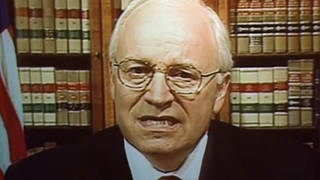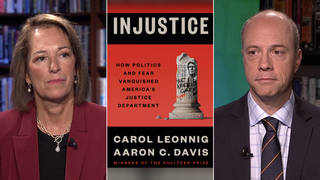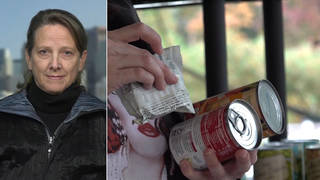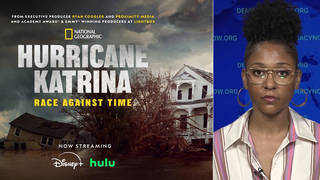
Guests
- Wendell PierceNew Orleans native, acclaimed actor, Tony Award-winning producer and community activist. His new book is The Wind in the Reeds: A Storm, a Play, and the City That Would Not Be Broken. Pierce starred in the HBO dramas Treme and The Wire, as well as the Oscar-nominated film Selma. He founded a nonprofit called Pontchartrain Park Community Development Corp. to build new affordable solar and geothermal homes for families displaced by Katrina.
- Monique Hardenco-director and attorney with the New Orleans-based Advocates for Environmental Human Rights.
- Gary Rivlinformer New York Times reporter, an investigative fellow at The Nation Institute and the author of four award-winning books: Fire on the Prairie, Drive-By, The Plot to Get Bill Gates and Broke, USA. His latest book is Katrina: After the Flood.
We spend the hour today marking the 10th anniversary of Hurricane Katrina, the 2005 storm that devastated the Gulf Coast and New Orleans, killing more than 1,800 people, forcing more than a million people to evacuate. Ten years after Hurricane Katrina, New Orleans has become a different city. The population is now about 385,000—about 80 percent of its pre-Katrina population. The number of African Americans has plunged by nearly 100,000 since the storm. According to the Urban League, the income gap between black and white residents has increased 37 percent since 2005. Thousands of homes, many in African-American neighborhoods, remain abandoned. On Thursday, President Obama spoke in New Orleans, remembering what happened 10 years ago. “We came to realize that what started out as a natural disaster became a man-made disaster — a failure of government to look out for its own citizens,” Obama said. We speak to actor Wendell Pierce, Monique Harden of the New Orleans-based Advocates for Environmental Human Rights, and Gary Rivlin, author of “Katrina: After the Flood.”
Transcript
JUAN GONZÁLEZ: We spend the hour today marking the 10th anniversary of Hurricane Katrina, the 2005 storm that devastated the Gulf Coast and New Orleans, killing more than 1,800 people, forcing more than a million people to evacuate. Ten years later, after Hurricane Katrina, New Orleans has become a different city. The population is now about 385,000—about 80 percent of its pre-Katrina population. The number of African Americans has plunged by nearly 100,000 since the storm. According to the Urban League, the income gap between black and white residents has increased 37 percent since 2005. Thousands of homes, many in African-American neighborhoods, remain abandoned.
On Thursday, President Obama spoke in New Orleans, remembering what happened 10 years ago.
PRESIDENT BARACK OBAMA: Here in New Orleans, a city that embodies a celebration of life suddenly seemed devoid of life. A place once defined by color and sound—the second line down the street, the crawfish boils in backyards, the music always in the air—suddenly was dark and silent. And the world watched in horror. We saw those rising waters drown the iconic streets of New Orleans; families stranded on rooftops; bodies in the streets; children crying, crowded in the Superdome—an American city, dark and under water. And this was something that was supposed to never happen here—maybe someplace else, but not here, not in America.
And we came to realize that what started out as a natural disaster became a man-made disaster—a failure of government to look out for its own citizens. And the storm laid bare a deeper tragedy that had been brewing for decades, because we came to understand that New Orleans, like so many cities and communities across the country, had for too long been plagued by structural inequalities that left too many people, especially poor people, especially people of color, without good jobs or affordable healthcare or decent housing.
AMY GOODMAN: President Obama went on to herald the progress New Orleans has made since Hurricane Katrina devastated the city 10 years ago.
PRESIDENT BARACK OBAMA: As hard as rebuilding levees is, as hard as rebuilding housing is, real change—real, lasting, structural change—that’s even harder. And it takes courage to experiment with new ideas and change the old ways of doing things. That’s hard. Getting it right and making sure that everybody is included and everybody has a fair shot at success, that takes time. That’s not unique to New Orleans. We’ve got those challenges all across the country. But I’m here to say, I’m here to hold up a mirror and say, because of you, the people of New Orleans, working together, this city is moving in the right direction. And I have never been more confident that together we will get to where we need to go.
AMY GOODMAN: Today we spend the hour looking at Hurricane Katrina and the state of New Orleans a decade after the storm. Joining us from New Orleans is Monique Harden, co-director and attorney with the New Orleans-based Advocates for Environmental Human Rights. Gary Rivlin is also in New Orleans, former New York Times reporter, investigative fellow at The Nation Institute. His latest book, Katrina: After the [Flood]. And joining us from Los Angeles, Wendell Pierce, a New Orleans native, acclaimed actor, Tony Award-winning producer and community activist. He may be best known for his roles in David Simon’s The Wire and Treme, about New Orleans and the musicians and the storm. Wendell Pierce’s new book is The Wind in the Reeds: A Storm, a Play, and the City That Would Not Be Broken. The story, in part, tells the story of Pierce’s great-grandfather, who came to New Orleans as a slave in the 1850s.
We welcome you all to Democracy Now! We’d like to start by asking each of you your thoughts on this 10-year anniversary of New Orleans. Wendell Pierce, why don’t we begin with you, New Orleans native? Where is New Orleans today? Where does it need to be?
WENDELL PIERCE: I’ll start in the words that Dickens gave us centuries ago: “It was the best of times, it was the worst of times.” It’s a tale of two cities. New Orleans, 10 years after Katrina, is definitely coming back. It is definitely thriving. It is definitely bringing in a new generation of entrepreneurial spirit. We’ve got new businesses, new restaurants, reformation of the schools, reformation of the levees and the water protection system and all. So there is a lot to celebrate. But we should never start a discussion about Katrina without remembering the 1,800-plus souls who lost their lives 10 years ago in that great flood of that great city. So we should always remember them.
It was the worst of times because we still are in a city that has an institutionalized system and point of view where there are those who don’t have our best interest at heart, if you live in certain parts of the city. It’s balkanized. It doesn’t give the same attention and resources that it does to other parts of the city. New Orleans is too small, and that’s the real kind of worrying part to me. It’s really too small to be so balkanized when it comes to giving resources, when it comes to best practices.
I remember I had a personal conversation with a chief of staff of the council president—this was some years ago—who literally told me, “I just don’t think the Lower Ninth Ward,” which was a poor, working-class, African-American neighborhood that was at the center of the storm—”I don’t think it is viable. I don’t think we should be giving our resources to it.” This is a woman who had the purse strings of the resources of the city. And I asked her, “Why?” She just said, “I just—I just don’t think so.” And I said, “Well, there’s no place you’ve been to in the Lower Ninth Ward you think is viable?” And then she had to admit, “Wendell, in my 40-plus years on this Earth, I’ve never been to the Lower Ninth Ward”—a place that is only a few miles away from City Hall, where she works every day. So, it is the best of times, it’s the worst of times.
JUAN GONZÁLEZ: And, Monique Harden of the Advocates for Environmental Human Rights, these 10 years, your thoughts, looking back on the reconstruction efforts that have occurred?
MONIQUE HARDEN: Well, I think what we’ve done over the last 10 years, looking back, is it’s really sharpened the focus on the human rights issues that are really underlying New Orleans, especially in post-Katrina era that we’re now living in, where we’ve seen billions of dollars of federal tax dollars spent in the name of recovery that have actually created one of the largest racial disparities that we’ve had in the history of not just New Orleans, but the Gulf region. And so, it’s not a situation of figuring out what’s the best way to go forward. The problem that we have is that there’s tension and conflict in the recovery planning. And this tension and conflict is—you know, is shown in terms of the balkanized neighborhoods, as Wendell just described to you.
AMY GOODMAN: And, Monique Harden, Governor Jindal, Republican presidential candidate, requesting of President Obama not to raise the issue of climate change? Of course, he defied the request and said it anyway. Jindal writing a letter to the president, saying, quote, “The temptation to stray into climate change politics should be resisted. While you and others may be of the opinion that we can legislate away hurricanes with higher taxes, business regulations and EPA power grabs, that is not a view shared by many Louisianians. I would ask you to respect this important time of remembrance by not inserting the divisive political agenda of liberal environmental activism”?
MONIQUE HARDEN: You know, I think Governor Bobby Jindal is a pathetic human being. I really do. And I think his letter speaks to just how controlled he is by the oil and gas industries that have taken over governance and policymaking and the resources in the state of Louisiana. I mean, just outside of the Governor’s Mansion in our state capital, you have one of the largest oil refinery complexes in the United States, and that’s owned by the, you know, ExxonMobil oil company. In the section between Baton Rouge, New Orleans and going down to the Gulf of Mexico, you’ve got over 200 petrochemical facilities in the section of—along the Mississippi River, we know as Cancer Alley, where predominantly African-American, indigenous communities bear the brunt of that pollution.
We’re living on the front lines of both the causes and effects of climate change. And because we love the places that we call home, in New Orleans and in surrounding areas, we’re fighting for changes in terms of how we can cut pollution in order to not only protect us from harmful chemicals that can cause asthma and cancer, but also, from those very same smokestacks and pipelines, we’re seeing the emission of global warming greenhouse gas emissions, that is warming the planet and creating, as a result of that, stronger hurricanes that we’re on the front lines of, as well. And so, dealing with the recovery and disaster response, these are all of one piece. And so, to talk about the recovery of New Orleans without talking about climate change would be like, you know, talking about the state of Louisiana without mentioning New Orleans.
AMY GOODMAN: This is—
MONIQUE HARDEN: So, it’s all of one piece.
AMY GOODMAN: This is what President Obama said.
PRESIDENT BARACK OBAMA: Making our communities more resilient is going to be increasingly important, because we’re going to see more extreme weather events as the result of climate change—deeper droughts, deadlier wildfires, stronger storms. That’s why, in addition to things like new and better levees, we’ve also been investing in restoring wetlands and other natural systems that are just as critical for storm protection.
JUAN GONZÁLEZ: I’d like to ask Gary Rivlin—your new book, Katrina: After the Flood, you spent a long time with The New York Times covering the aftermath of Katrina—your thoughts now in this 10-year commemoration and some of the people that you focused on in your book?
GARY RIVLIN: Right. So, it was not an equal opportunity storm. If you were a black homeowner in New Orleans, you were more than three times more likely to have a flooded home than if you were a white homeowner. And it has not been an equal opportunity recovery. You could look at Lakeview, a prosperous white community that was completely flooded. Ten years later, it’s 100 percent back. It’s arguably better than ever. You look at New Orleans East, a black professional-class, middle-class neighborhood, 10 years after the storm, it’s maybe 80 percent back. You look at Seventh Ward, a black working-class neighborhood, 50 percent, 60 percent back.
And the great shame of it is, it’s based on many factors—a lack of wealth, perhaps, in the black community versus the white—but it’s also based on policy. There were policies put in place that got in the way of the recovery, that made for an unequal recovery. New Orleans today has the second-highest rate of—the second-highest gap between rich and poor of any city in the country but one. And it’s not accidental. The website FiveThirtyEight pointed out that in the year 2000 the average black middle-class family was making $30,000. Thirteen years later, 2013, that same family was making $25,000—making less money today.
AMY GOODMAN: We’re going to break and then come back to this discussion. We’re speaking with Gary Rivlin. He is the former New York Times reporter. His new book, Katrina: After the [Flood]. Wendell Pierce also with us, the famous actor, also author. His new book, The Wind in the Reeds: A Storm, a Play, and the City That Would Not Be Broken. And Monique Harden, the environmental attorney who heads Advocates for Environmental Human Rights in New Orleans. This is Democracy Now! on this 10th anniversary of Hurricane Katrina. Stay with us.
[break]
AMY GOODMAN: New Orleans native, Louis Armstrong, singing “Do You Know What It Means to Miss New Orleans?” This is Democracy Now!, democracynow.org, The War and Peace Report. I’m Amy Goodman, with Juan González, as we spend the hour on this 10th anniversary of Hurricane Katrina looking at New Orleans. Let’s turn back to some of the voices of New Orleans residents who sought refuge at the Superdome and Convention Center after the storm.
NEW ORLEANS RESIDENTS: Help! Help! Help! Help! Help! Help! Help! Help! Help! Help! Help! Help! Help! Help! Help! Help! Help! Help! Help! Help! Help! Help! Help! Help! Help! Help! Help!
SURVIVOR 1: These babies. Six and eight months. The people just walking past us.
SURVIVOR 2: We’ve got children that got asthma. They’re sick. They don’t have no kind of relief.
SURVIVOR 3: No food, no water, no nothing. Whatever we have, we’ve been taking it. That’s the only way we can survive.
SURVIVOR 4: They got the food right here. Let me show you, right here. This is where they got the food at. All of it, look. Right here, look. City won’t give us nothing! Nothing!
SURVIVOR 5: Gotta help ourselves, right? Open the gate right there.
SURVIVOR 4: Look, look, look! Look, they won’t give us nothing! We ain’t drinking no ice water! Nothing! Because we can’t get it.
SURVIVOR 6: There’s nobody in charge—the National Guard. There’s the police. There is nobody. Somebody needs to come take charge and put organization and get these people to safety, to get them clothes, the basic things that they need to live from day to day.
SURVIVOR 7: This is not about low income. It’s not about rich people, poor people. It’s about people! Nobody wants to hurt anybody in this city! Nobody wants to hurt these people who have these businesses! We want a little air and a little food and water, for God’s sake! That’s it!
JUAN GONZÁLEZ: Those were some of the voices of New Orleans residents in the days after the storm 10 years ago.












Media Options